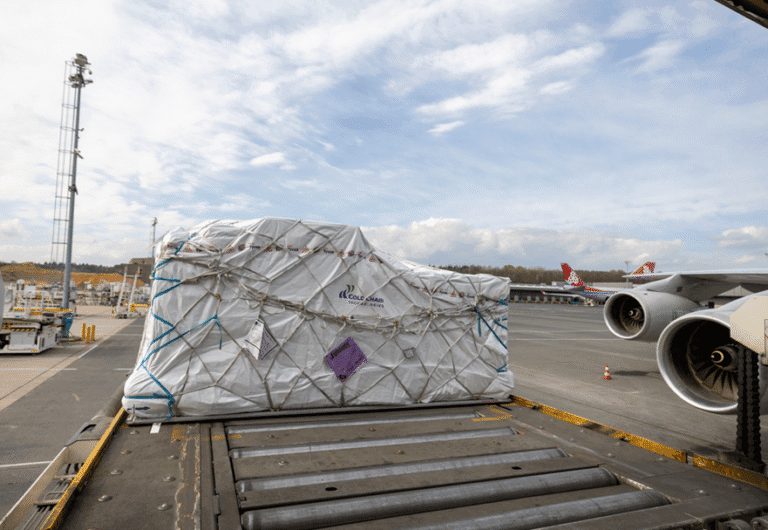- Latin America’s pharma cold chain faces its toughest test yet, with most temperature breaches happening on scorching airport ramps.
- São Paulo’s GRU Airport is raising the bar with real-time tracking, CEIV Pharma standards, and smarter handling to keep medicines safe.
- Collaboration and innovation—from high-tech thermal covers to unified processes—are key to protecting patients and powering a stronger, cooler supply chain.
Maintaining the integrity of temperature-sensitive pharmaceuticals during airfreight remains one of the most pressing logistical challenges in Latin America. While cold chain management has evolved significantly in Europe and North America, LATAM airports continue to face systemic hurdles, particularly when cargo is exposed to extreme temperatures on airport ramps.
Airfreight globally accounts for roughly 80 percent of reported temperature excursions, with around 60 percent occurring when cargo sits on the tarmac. For Latin America, this issue is compounded by long cross-hemispheric routes. “Long routes across climate zones increase exposure to temperature variations,” explains Marcelo Mazzali, Management and Quality System at GRU Airport. Handling companies in the region also often lack certification in best practices, further heightening risk.
The silent threat
The airport ramp is widely regarded as the most dangerous exposure point for pharmaceuticals. “Ramps are the most critical exposure location in an airport,” Mazzali says, “due to the combination of exposure to the elements, surfaces over 30°C, strong sun, tropical rain, and high humidity.”
These conditions generate multiple thermal risks: direct solar radiation, hot asphalt that re-radiates heat, convective heating from ambient air, and a greenhouse effect inside common plastic film. Mazzali warns that current testing standards often underestimate this threat. “Many laboratories use thermal chambers to simulate time and temperature, but it is not truly representative. Solar energy can be ten times more stressful to product temperature than ambient air exposure,” he notes.
The consequences for pharmaceutical cargo are significant. Exposure on the tarmac consumes valuable temperature-stabilisation time, effectively accelerating the degradation of sensitive products. “When the load is exposed to heat on the tarmac, it ends up consuming the temperature stabilisation time and accelerating the time in hours of temperature maintenance,” Luiza Cervetto, Global Marketing Manager at Cold Chain Technologies, emphasises.
Critical Gaps
Beyond ramps, other key risk areas include dock and loading zones, yards, and customs. Boxes often sit on forklifts while paperwork is processed or remain in trucks with engines off, allowing temperatures to climb quickly. At warehouse ‘zero point’ racks, pallets can be exposed to ambient temperatures before reaching cold storage. Even brief customs or X-ray delays—normally two hours—can stretch to 24 hours during holidays or system outages.
“Recommended practice is to not leave cargo on the ramp for more than five minutes,” Cervetto explains. “The reality in Latin America is closer to an average of two and a half to three hours, and we’ve seen delays of up to 12 hours.”
Addressing these challenges requires streamlined processes, standard operating procedures, and greater collaboration among stakeholders. Technological solutions such as thermal blankets and data loggers also provide additional protection and critical visibility.
São Paulo’s solution
While many LATAM airports are still developing cold chain infrastructure, some are beginning to set benchmarks. São Paulo’s GRU Airport, for example, handles around 21,000 tons of cargo per day, with 30 percent classified as pharmaceutical.
“GRU invested in certifications such as CEIV Pharma, continuous process improvement, automated systems, temperature discrepancy alerts, and tighter receiving, storage, and shipping SLAs,” Mazzali notes. These measures are designed to reduce temperature excursions and enhance operational flow.
Real-time tracking plays a pivotal role. “By providing continuous monitoring of location and temperature conditions, it allows all stakeholders to detect issues as they occur, not after the fact,” Mazzali explains. Quick decisions can then be made to reroute shipments, adjust storage, or notify response teams, protecting product quality and reducing waste.
Innovations in thermal protection
Advanced thermal blankets are gaining traction across the region. Cold Chain Technologies evaluated 18 thermal covers using both ramp-exposure tests and environmental chamber simulations. “Even basic thermal cover can extend temperature protection for several additional hours,” says Cervetto.
Interestingly, performance does not always correlate with thickness. “Most blankets work using a basic insulation principle—the thicker they are, the more they protect. The exception is CCT’s covers, which protect from radiation rather than air temperature. This illustrates the risks posed by solar radiation compared to ambient air.”
Lessons learned
Past failures highlight the need for tighter oversight. Mazzali recounts an anonymous biotechnology shipment from Germany: due to reused packaging and mislabelled temperature requirements, a 2 to 8°C shipment was treated incorrectly, resulting in total loss. “We now prioritise checking the temperature between the packaging and the system and resolving the problem within an SLA of one to two hours maximum,” he says.
Effective collaboration across shippers, airlines, ground handlers, and suppliers remains critical. “Harmonise and simplify processes! By promoting best practices and aligning operations, stakeholders can improve communication, reduce delays, and deliver a higher standard of service,” Mazzali stresses.
With Brazil emerging as a major pharmaceutical export hub, stakeholders are adapting to meet international compliance standards. Some companies now invest in qualified packaging and validated thermal blankets, while regulatory agencies like ANVISA must step up monitoring and legislation.
Looking ahead, Cervetto emphasises education and data sharing. “Processes are only as good as their weakest link, so there must be a coordinated approach between airlines, airports, customs authorities, 3PLs, and solution providers such as Cold Chain Technologies.”
Strengthening Latin America’s cold chain is a matter of urgency. As Cervetto concludes, “By understanding weaknesses, leveraging technology, and fostering collaboration, the region can reduce tarmac times, protect patient safety, and build a resilient pharmaceutical supply chain.”





